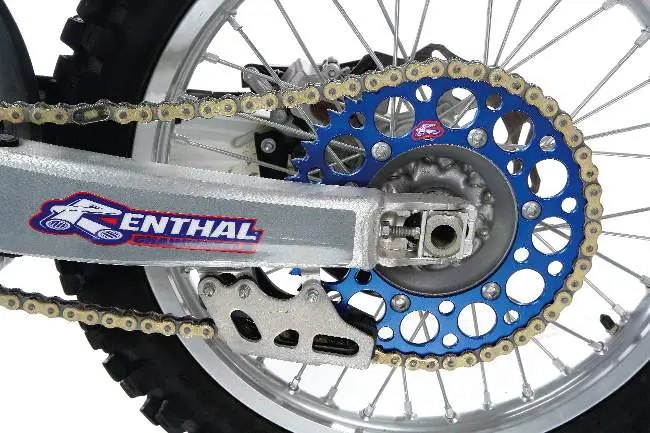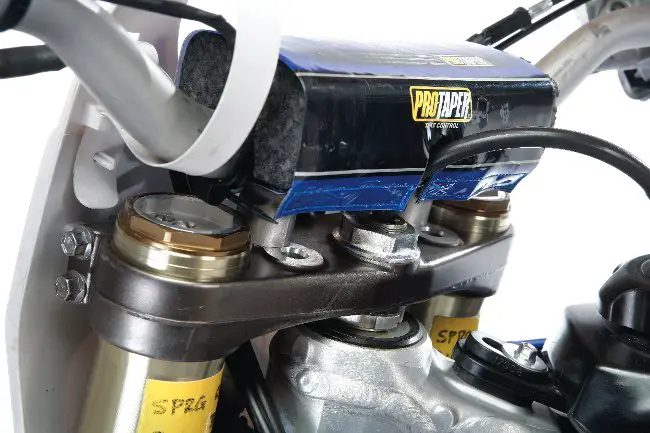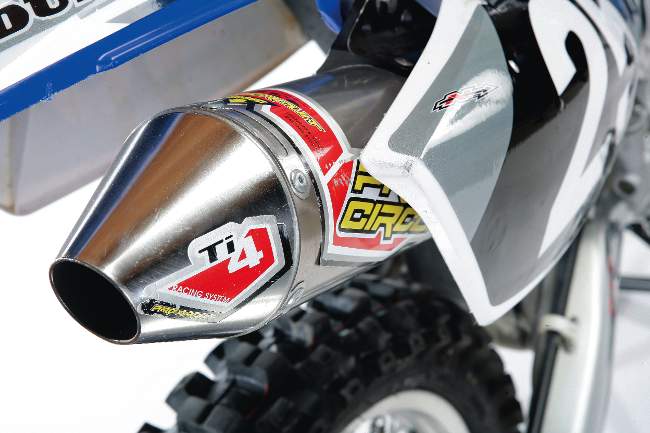MXA’S USED MOTOCROSS BIKE GUIDE: HOW TO SETUP YOUR 2010 YAMAHA YZ250F:

This is the 2010 Yamaha YZ250F the way the MXA test crew raced it. As a rule, we don’t go for exotic or expensive mods, but if push comes to shove, we will seek competent help (no matter how much it costs). Use MXA‘s mods as a guide.

Gearing: In stock trim, the 2010 YZ250F powerband is blessed with a ferocious bottom-end hit, but once the engine reaches the midrange, the power falls off harder than a sorority girl on a mechanical bull, then it tries rto go again when you can’t use it. Some test rider preferred a taller 48-tooth rear sprocket (stock is 49) to expand the small gaps between gears, other went down in the gear to a 50 to forget about the lower gears and to try to get to third quicker. Renthal provided the stock-toothed countershaft and smaller or larger rear sprocket, as well as a gold chain.

Front brake: The stock front brake is so-so. As Tim Allen would say, the MXA wrecking crew was looking for “more power!” We ditched the stock front rotor for a beefy Brembo 270mm rotor with a billet bracket . The oversized rotor provided progressive stopping power, especially when coupled with the stock brake pads. For more info, go to www.dubyausa.com.

Forks: Heavier riders will need stiffer fork springs to keep the Kayaba SSS forks from blowing through their stroke. We swapped the stock 0.45 kg/mm springs for 0.46 kg/mm springs and found relief, but it was necessary to drain 20cc of oil out of each fork leg to minimize midstroke harshness. Lighter riders can stick with the stock springs but should lower the oil volume to erase the midstroke jolt. The 2010 frame geometry seemed to change the fork performance by putting more weight on the front end compared to the 2009 model, but the real reason comes from the different valving. Yamaha added more high-speed rebound damping and low-speed compression damping, while decreasing high-speed compression damping for 2010. We don’t approve.
For hardcore racing these are MXA’s recommended 2010 Yamaha YZ250F fork settings (stock settings are in parentheses).
Spring rate: 0.46 kg/mm (0.45 kg/mm)
Oil quantity: 350cc
Compression: 2 clicks out (8 clicks out stock)
Rebound: 8 clicks out (10 clicks out stock)
Fork leg height: 5mm up
Notes: Slower and smaller riders can get away with using the stock 0.45 kg/mm fork spring rate, but heavier riders (over 160 pounds) should jump up a spring rate. Doing so will keep the forks up in their stroke and help prevent the the forks from diving.
Shock: In stock trim the Kayaba suspension isn’t very well balanced. Yamaha was close in their baseline settings, but the shock feels high in the stroke. We increased the race sag to 105mm (Yamaha recommends between 95-105mm). We also slowed down the rebound and went in on low-speed compression. For hardcore racing this is MXA’s recommended 2010 YZ250F shock settings .
Spring rate: 5.3 kg/mm
Race sag: 105mm
Hi-compression: 2-1/4 turns out (1-3/4 turns out stock)
Lo-compression: 7 clicks out (9 clicks out stock)
Rebound: 9 clicks out (10 clicks out stock)
Notes: Riders who don’t need heavier fork springs rates should run upwards of 105mm of sag.

Bar mounts: A simple and cheap fix for taller riders is to move the bar mounts to the forward mounting position. Very tall riders should opt for the mounts turned forward. Most riders will find that the bar mounts turned back in the forward position are most comfortable.

Exhaust pipe: Searching for more power in the midrange through the top-end, we ordered a Pro Circuit Ti-4R exhaust system. Of all the YZ250F pipes we tested, the Ti-4R had the most pro-level exhaust. It traded bottom-end response for a free-revving top. The pipe passes the AMA sound test.

Miscellaneous: We loved the Bridgestone 403A/404 tire combination that came stock on the 2010 YZ250F. Once the tread wore out, we tried the Dunlop MX51 rear with an MX31 front?this worked well in intermediate to soft terrain, but the Bridgies are better overall.

Jetting: Here are MXA’s recommended jetting specs:
Main jet: 180
Pilot: 45
Needle: NDJR
Clip position: 4th from top
Fuel screw: 3/4 turn out (1-3/4 turns out)
Leak jet: 70
Notes: Yamaha’s initial literature listed the fuel screw at 2-1/4 turns out, but Yamaha changed the fuel screw to 1-3/4 turns out for production. The needle is richer by a half clip compared to the 2009 needle. For high altitude we recommend switching to a 178 main jet with the clip in the 3rd position. For cold weather we recommend swapping the 180 main jet for a 182 and adjust the fuel screw to 2-1/4 turns out.




Comments are closed.